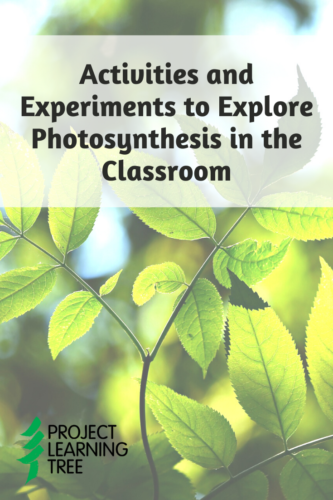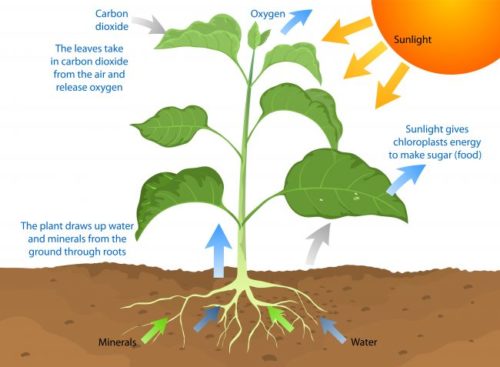 Every time you take a deep breath or eat your favorite meal, you have plants to thank. That’s because plants release oxygen and provide nutrition for every animal on earth. Learning about the ins and outs of photosynthesis will help your students understand how plants provide these life-sustaining elements.
Every time you take a deep breath or eat your favorite meal, you have plants to thank. That’s because plants release oxygen and provide nutrition for every animal on earth. Learning about the ins and outs of photosynthesis will help your students understand how plants provide these life-sustaining elements.
Photosynthesis can be a difficult concept to grasp, that’s why we’ve compiled a selection of hands-on activities and experiments to help show students some of the concepts in action.
In addition to the ideas below, PLT’s new Explore Your Environment: K-8 Activity Guide and PLT’s PreK-8 Environmental Education Activity Guide both offer a wealth of hands-on, creative activities and resources for lessons about photosynthesis. Each guide includes a comprehensive Topic Index to help you quickly find a list of relevant activities that fit your needs and every activity includes a background section for educators that gives a science-based introduction to the activity’s content. We also have a few abridged versions related to the physiology of trees and photosynthesis for families to try out together at home, for example, How Plants Grow and Tree Factory.
Introduction to Photosynthesis
The word “photosynthesis” comes from Greek root words that combine to mean “to put together with the help of light.”
All plants, algae, and some microorganisms like bacteria photosynthesize to make their own food. This makes them part of a group of organisms called autotrophs. Unlike heterotrophs, which include animals that feed off other living organisms, autotrophs make nutritional organic substances from simple inorganic substances. What a superpower!
To undergo photosynthesis, plants need carbon dioxide from the air, water from the soil, and sunlight. These elements combine in a chemical reaction that takes place inside of a plant’s leaves to create glucose and oxygen.
Absorbing Carbon Dioxide and Water
Carbon dioxide can be produced naturally from the decomposition of living things and events like volcanic eruptions, and from human activity like burning fossil fuels.
Animals respirate by inhaling gases in the air, retaining oxygen, and releasing carbon dioxide. However, when plants breathe, they take in carbon dioxide, which is a key ingredient required for photosynthesis. Carbon dioxide enters a plant through its stomata, tiny pores that are usually located on the underside of leaves and sometimes stems. Most plants also soak up another substance through their roots that they need for photosynthesis: water.
Adding Energy
Once a plant has carbon dioxide and water, it needs energy to enable these two substances to chemically react with each other. It gets energy from a steady stream of sunlight hitting its leaves. Chlorophyll, a green pigment found in tiny structures called chloroplasts within leaves, absorbs energy from blue and red light waves from the sun. The sunlight’s energy is then transferred to two types of energy-storing molecules within the plant.
The energy already stored from the sun fuels a reaction in the leaves’ chloroplasts that splits water molecules (H20) into pure hydrogen (H) and oxygen (O2). The hydrogen reacts with carbon dioxide (CO2) to produce glucose, a type of sugar. The full chemical equation of photosynthesis looks like this:
6CO2 + 6H20 + Sunlight → C6H12O6 + 6O2
In other words, the carbon dioxide and water that go into the plant combine with energy from sunlight to produce glucose, and also oxygen.
Storing and Using Glucose
Once this sugar is made, it can be stored as energy (food) that the plant uses for growth and repair. Plants also use the energy from nutrients in the soil along with glucose to grow and develop leaves, flowers, and fruits.
Students often wonder how a gas like carbon dioxide that you can’t see helps form a giant tree or the apple they eat for lunch. It’s because a chemical reaction doesn’t have to start with a solid (like soil) to end with a solid (like a tree or apple). It helps for students to understand the carbon cycle – and PLT has a variety of content to support this.
Glucose is a carbohydrate, which is simply a molecule containing carbon, hydrogen, and oxygen. Smaller glucose molecules can build bigger carbohydrates like cellulose or starch.
Similar to a human skeleton, cellulose is the main component of plant cell walls that help strengthen the plant. Humans can’t digest cellulose, but the fiber found in cellulose-heavy foods like celery and broccoli aids with digestion and can lower the risk of diseases like cancer. These strong fibers are also used to make clothes and paper. Animals like cows, horses, and sheep can digest cellulose, so it makes sense that they eat grass for quick energy and nutrients.
Plants can also convert glucose into starch, which is a larger carbohydrate molecule that can store its energy. Humans break down starches found in foods like potatoes and rice into glucose, and it, in turn, gives them energy.
Though you may not use sunlight to create your food, when you eat something like chicken or rice, you take in energy plants used from the sun. And not only does a plant produce food animals need for their energy as a result of photosynthesis, but it also releases oxygen as a byproduct through its stomata into the atmosphere.
Photosynthesis is critical for the survival of all living organisms — not just plants.
Hands-On Photosynthesis Activities
Photosynthesis can be a difficult concept to grasp, especially for younger learners. That’s why we’ve compiled these interactive activities and experiments that show some of the concepts in action.
Photosynthesis Visuals
These photosynthesis modeling activities will help students visualize and better understand what a plant needs to undergo photosynthesis and what it produces as a result. The 3D and 2D representations will also help them absorb some of the vocabulary associated with photosynthesis.
3D Photosynthesis: Tree Leaf Model
Older students can create these more complex 3D models of a leaf’s front and backside where all of the photosynthesis action takes place, like on its stomata and chloroplasts. They will attach labels to the leaf that describe the different substances involved.
The Ins and Outs of Photosynthesis
Younger learners will enjoy this less complex visual activity that involves a leaf with “IN” and “OUT” envelopes into which they’ll place the respective chemical reactants or products of photosynthesis.
Photosynthesis Paper Craft
Take your lesson in an artistic direction by letting students create these bright and fun paper flower and sun displays, complete with the basic photosynthesis terms.
Exploring Leaves with STEM
These STEM experiments requiring real leaves will spark valuable critical thinking when students observe leaf structure, stomata, plant respiration, and more.
Respirating Leaves
The invisible chemical process of a leaf exchanging carbon dioxide, water, and sunlight for oxygen will become visible when your class observes what happens when they submerge leaves in water.
Stomata Microscope Investigation
Students will use microscopes to explore the structure of a leaf that makes the exchange of gasses during photosynthesis possible. They can also explore other parts of leaves and how plants gain mass.
Stomata Microscope Comparison
Compare the stomata sizes and numbers of different plant species under a microscope and examine leaf texture by creating cool “nail polish imprints.”
Exploring Plants and Sunlight
Plants need sunlight for survival, so it makes sense that their behavior or appearance would change if their access to sunlight is altered. These activities explore this concept.
Measuring Plant Growth with Sunlight
This activity takes a couple of weeks but will give your students valuable insight into how a plant’s growth and green coloration is affected by varying levels of sunlight over time. They’ll flex their critical thinking skills as they take daily notes and conclude what happens to a seed under different light conditions.
Rotating Plants
Track how plants bend towards the sun wherever they are with this great exercise that introduces young students to just how active plants can be when it comes to gaining precious sun energy. You can grow seedlings or even experiment with a larger plant you have and see how its color or growth is affected when you rotate or move closer or further from the sun.
Fun with Plant Pigmentation
There’s a lot of fun that can be had with the chlorophyll in leaves, including art and color experimentation!
Chlorophyll Paintings
Chlorophyll pigment not only turns plants green – it makes leaves great mediums for “green” art projects! Kids will love this out-of-the-box painting style, learn about chlorophyll firsthand, and expand their creativity all at once.
Leaf Color Chemistry Experiment
When the school year begins, recreate how leaves change color in autumn with green leaves, rubbing alcohol, coffee filters, and other easy-to-find items. The pigments of chlorophyll will fade and leave behind hidden pigments that demonstrate why leaves change color in the fall – which is also when your class can reflect back on this eye-opening experiment.
Let Project Learning Tree Be Your Guide
Introduce students to photosynthesis with these PLT activities from the new Explore Your Environment: K-8 Activity Guide:
- Here We Grow Again (for grades K-2), Every Tree for Itself, and Signs of Fall (for grades 3-5) in PLT’s Explore Your Environment: K-8 Activity Guide
- How Plants Grow and Sunlight and Shades of Green (Activities 41 and 42 in PLT’s PreK-8 Environmental Education Activity Guide), and
- Power Plants (Activity 4 in PLT’s Energy & Ecosystems E-Unit).
Watch an example of an activity! This video walks viewers through PLT’s activity Signs of Fall. In this activity, participants are introduced to different leaf pigments and use chromatography to pull out leaf pigments using simple household items. It helps answer the question, “Why do leaves change color?”.
For further guidance on how to relay the essential concepts of photosynthesis to your classroom and more great activities, check out this Unit of Instruction by Project Learning Tree. It suggests linking select PLT activities to help students learn more about the topic of photosynthesis using a storyline technique. Storylines ensure connectivity and continuity between individual activities and can serve as the “instructional glue” that bind many areas of knowledge and skills. The Unit of Instruction includes a guiding question, concepts addressed, and connections to the Next Generation Science Standards (NGSS) and PLT’s Forest Literacy Framework.
To boost your teaching with 50 field-tested, hands-on multidisciplinary activities that educate and connect elementary students with nature in powerful ways, and more suggested Units of Instruction, look no further than Project Learning Tree’s new Explore Your Environment: K-8 Activity Guide.



